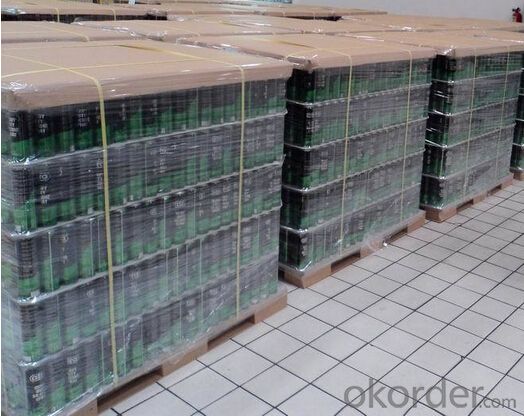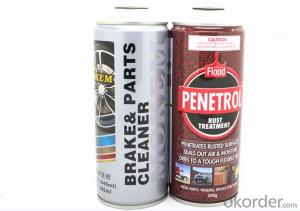4 Colors Printing Spray Paint Aerosol Tin Can
- Loading Port:
- China main port
- Payment Terms:
- TT OR LC
- Min Order Qty:
- 50000 PCS
- Supply Capability:
- 300000000 PCS/month
OKorder Service Pledge
OKorder Financial Service
You Might Also Like
1.Brief description
Content: spray paint
Printing: CMYK printing as Per Customer Design
2. Detailed Specification
Metal Type: Tinplate Use: Aerosol
Model Number: diameter 45, 52, 57, 60, 65mm
material: tinplate
height: 80-300mm
can type: necked-in
diameter: 45, 52, 57, 60, 65mm
thickness of can body: 0.18mm/ 0.20mm/as required
thickness of cone and done:0.25/0.28/0.32/ as required
3.Usage:
suitable for insecticide, air freshener, body spray, lighter refill, car care etc
4.Advantages of us
1.With ISO9001:2008 certification
2. Over 20 years in producing tin cans
3. Annual capacity: over 400 million pcs
4. Introduced the most advanced iron-printing machine from Japan and Germany, also several full-automatic & high-speed(300pc/minute) can-making lines from Europe.
5. Our products include diameter 45mm, 52mm, 57mm, 60mm, 65mm, 70mm, the can height is from 80-300mm differently
5. Package

5.FAQ
1. Delivery Time:15-25 days, time can be shorten upon customer’s situation
2. Productivity:1,000,000 Cans/Day; 500,000 Printing Sheets/Day
3. MOQ:50,000pcs, but finally upon your size
4. Payment Term: 30% TT in advance, 70% balance against BL copy; 100% by LC at sight
- Q:Can tinplate be used for electrical components?
- Yes, tinplate can be used for electrical components. Tinplate is a type of steel coated with a thin layer of tin, which provides good electrical conductivity and corrosion resistance. It is commonly used for manufacturing electrical components such as connectors, terminals, and shielding materials.
- Q:What are the main factors influencing the consumer preferences for tinplate packaging?
- The main factors influencing consumer preferences for tinplate packaging include its durability and ability to protect products, its recyclability and sustainability, its aesthetic appeal, the perception of higher quality and prestige associated with it, and the convenience and functionality it offers in terms of storage and opening.
- Q:How is tinplate coated with water-based paints?
- Tinplate is coated with water-based paints through a process called coil coating. In this process, the tinplate is cleaned, pre-treated, and then coated with a water-based paint using a roller or spray method. The paint is then dried and cured at high temperatures to ensure adhesion and durability. The water-based paints are preferred due to their environmental friendliness and ease of application.
- Q:What are the common misconceptions about tinplate packaging?
- One common misconception about tinplate packaging is that it is easily dented or damaged. In reality, tinplate is quite durable and can withstand rough handling without losing its structural integrity. Another misconception is that tinplate packaging is not environmentally friendly. However, tinplate is highly recyclable and can be reused multiple times, making it a sustainable packaging option.
- Q:What are the different ways to open tinplate containers?
- There are several ways to open tinplate containers, including using a can opener, a pair of scissors, a knife, or pulling the tab if it is a pop-top can.
- Q:What are the potential health risks associated with tinplate packaging?
- The potential health risks associated with tinplate packaging are primarily related to the presence of bisphenol A (BPA), a chemical used in the lining of some tin cans. BPA can potentially leach into the food or beverage stored in the can, and prolonged exposure to BPA has been linked to various health issues, including reproductive disorders, cardiovascular problems, and certain types of cancer. However, it's important to note that many countries have regulations in place to limit BPA levels in packaging materials, and alternative lining materials are being developed to minimize these risks.
- Q:What are the main applications of tinplate in the pharmaceutical industry?
- Tinplate is primarily used in the pharmaceutical industry for packaging purposes. Its main applications include the production of tinplate cans, containers, and closures. These tinplate packaging solutions provide a reliable and durable barrier against moisture, light, and oxygen, ensuring the protection and preservation of pharmaceutical products. Additionally, tinplate is also used for labeling and promotional purposes due to its excellent printability and aesthetic appeal.
- Q:Can tinplate be used for packaging industrial products?
- Yes, tinplate can be used for packaging industrial products. Tinplate is a type of steel coated with a thin layer of tin, which makes it highly resistant to corrosion and provides a protective barrier for the packaged products. It is commonly used for packaging industrial products such as chemicals, paints, oils, and other materials that require a durable and secure packaging solution.
- Q:How is tinplate affected by different types of beverages?
- Tinplate is generally resistant to most types of beverages, including acidic ones. However, certain highly acidic or corrosive beverages, such as fruit juices, can cause a chemical reaction with the tin coating, potentially leading to a metallic taste or discoloration. To prevent this, tinplate cans are often lined with a protective coating, such as lacquer or polymer, to ensure the beverage's quality and safety.
- Q:How has tinplate evolved over the years?
- Tinplate has evolved significantly over the years in terms of its production process, durability, and applications. Initially, tinplate was made by coating iron sheets with a thin layer of tin to prevent corrosion. However, as technology advanced, electroplating replaced the traditional hot-dipping method, resulting in a more efficient and cost-effective production process. Additionally, the development of various alloy coatings has further enhanced the durability of tinplate, making it more resistant to rust and damage. Moreover, tinplate has expanded its applications beyond traditional cans, finding its way into packaging for food, beverages, aerosols, and cosmetics. Overall, the evolution of tinplate has revolutionized the packaging industry, offering improved quality, versatility, and sustainability.
1. Manufacturer Overview |
|
|---|---|
| Location | |
| Year Established | |
| Annual Output Value | |
| Main Markets | |
| Company Certifications | |
2. Manufacturer Certificates |
|
|---|---|
| a) Certification Name | |
| Range | |
| Reference | |
| Validity Period | |
3. Manufacturer Capability |
|
|---|---|
| a)Trade Capacity | |
| Nearest Port | |
| Export Percentage | |
| No.of Employees in Trade Department | |
| Language Spoken: | |
| b)Factory Information | |
| Factory Size: | |
| No. of Production Lines | |
| Contract Manufacturing | |
| Product Price Range | |
Send your message to us
4 Colors Printing Spray Paint Aerosol Tin Can
- Loading Port:
- China main port
- Payment Terms:
- TT OR LC
- Min Order Qty:
- 50000 PCS
- Supply Capability:
- 300000000 PCS/month
OKorder Service Pledge
OKorder Financial Service
Similar products
New products
Hot products
Related keywords



























